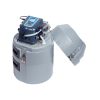Hach AS950 Pressurized Sampling Relay Module
Features
- Low-voltage connections for optional flow pacing and sampler program control
- Compatible with AS950 portable, refrigerated and all-weather refrigerated samplers
- IP66 / NEMA 4X enclosure rating for outdoor use
- Free ground shipping
- Expedited repair and warranty service
- Lifetime technical support
- More
The pressurized sampling relay module has a high-voltage relay for automatic sample collection from a pressurized sample line. The module also has low-voltage connections for optional flow pacing and sampler program control. The module can be used with a portable, refrigerated or an All-Weather Refrigerated Sampler (AWRS) that has the AS950 controller.
| Cable Length | Auxiliary cable, 7-pin |
| Certifications | CE, UL/CSA standards (cETLus) |
| Dimensions | 160 x 80 x 86 mm (6.30 x 3.15 x 3.39 in.) |
| Enclosure Rating | IP66 / NEMA 4X |
| Operating Conditions | -30° C (-22° F) - 50°C (122°F) |
| Power Input | 12 - 15 V DC, 0.31 A (from the AS950 controller) |
| Relay Functions | 5 A maximum resistive load at 240 VAC, 1/8 HP at 120 VAC, 1/4 HP at 240 VAC |
| Weight | 0.59 kg (1.3 lbs) |
In The News
Monitoring Meadowbrook Creek: Real-Time Data Collection in an Urban Creek
Meadowbrook Creek in Syracuse, New York, has been monitored by Syracuse University (SU) faculty and students for over a decade. Originally established by Dr. Laura Lautz in 2012, the early years of the program focused on collecting grab water samples for laboratory analysis and evaluating the impact of urban land use, human activities, and natural processes on water resources. Tao Wen , an Assistant Professor in SU’s Department of Earth and Environmental Sciences, took over the program in 2020 and upgraded the existing systems to include 4G modems that allowed for real-time data viewing. [caption id="attachment_39339" align="alignnone" width="940"] An overview of the Fellows Ave monitoring station along Meadowbrook Creek.
Read MoreLancaster County Makes the Switch to Real-Time Water Quality Monitoring Systems
Continuous data collection in Lancaster County, Pennsylvania, started about 5 years ago, and the county will be making a major upgrade over the next year—switching from relying solely on the internal storage of water quality sondes to telemetry units that enable real-time data viewing. [caption id="attachment_39295" align="alignnone" width="940"] The first telemetry unit was installed at LCCD along Little Conestoga Creek. (Credit: Tyler Keefer / LCCD) [/caption] Telling Lancaster County's Story Through Data Since the Lancaster County Conservation District started monitoring county waterways, the goal has remained the same, according to Amanda Goldsmith, Watershed Specialist for the Watershed Department.
Read MoreFrom Florida to the World: How a Smithsonian Research Station is Bridging Gaps in Marine Biology
In the early 2000s, along the coast of northern California, where the redwoods dominate the forests, and the Pacific Ocean shapes shorelines, a Humboldt University undergraduate student took the first steps into a lifelong love of marine biology. Dean Janiak accepted an invitation to help a graduate student with fieldwork in rocky coastal tide pools, and so began a journey that led him from California to Connecticut to Florida and eventually to the world, where he has facilitated research in communities across the globe. While finishing up his masters of Oceanography from the University of Connecticut, Janiak continued researching fouling communities–marine life that live on hard, often artificial surfaces such as docks–at the Smithsonian Environmental Research Center.
Read More







